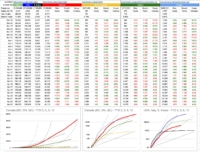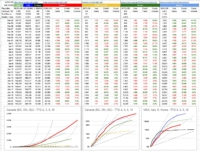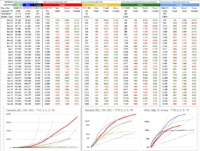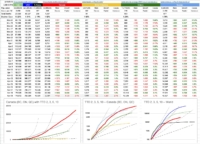Share...
Day 38 – April 23, 2020
When I was a kid, I was taught that the dinosaurs died out sixty-five million years ago. More recently, my kids, when they were in elementary school studying dinosaurs… were taught that they died out sixty-six million years ago. How exactly did a million years elapse in less than 50? Was it at 65,999,980 in the late 70s, and it just recently “rolled” over to 66?
No… but something must have changed, and it did, from various directions. Geophysicists, geologists, palaeontologists and other researchers… all working on completely different things — some drilling for oil in the Gulf of Mexico, some working on hypotheses regarding the mass-extinction event from around 65 million years ago, some researching a very thin but fossil-diverse soil layer in New Jersey from around that time period… at some point, in the early 80s, someone asked the “what if…?” of a meteor/asteroid/comet slamming into earth might hold some explanations… and indeed, the puzzle pieces all fit. And, further to that, if that were the case, we should also be finding other things, specifically… well, this and that, and when “this and that” were searched for, they were found. Including dating that massive crater to just over 66 million years.
That crater (the Chicxulub crater — 100km wide, 30km deep) was caused by a piece of rock somewhere between 11 and 81 km in diameter, slamming into the earth with a force of somewhere around 500 billion Hiroshima A-bombs. That’s a lot of bombs… so let’s do some ridiculous math…
Each bomb is 3 metres long…. so if we line them up, end to end, that’s 1.5 billion km. That’s from earth, to the sun… and back. Five times. Or back and forth to Mars, four times. Or one, nice long line of A-bombs… from here to Saturn.
So imagine all that firepower concentrated in one spot, all blowing up at once. It’s a wonder the earth itself survived. It did, though the massive earthquakes and tsunamis and acid rain and volcanic eruptions and blocked-out sun for years… did not make for great living conditions. All of the terrestrial-based dinosaurs were wiped out, and all that’s left of them are the ones that could literally fly above disaster below. Indeed, from a dinosaur’s point of view, we are all living in … [Continue Reading]
Day 37 – April 22, 2020
I left the house yesterday, for the first time in a while. Some things need to be done in person… I drove downtown to my bank’s main branch, one of the few that’s open. With all of it pre-arranged, I put on a mask, gloves… walked in, put down a piece of paper, grabbed some cash and left. It took less than 2 minutes. I’d like to pretend the mask was so they wouldn’t know who I am, and the gloves so I wouldn’t leave fingerprints. The piece of paper would’ve been a stick-up note, of course… I was alone, so I just went back to the car and drove home… but I wish I’d have had a driver, so I could’ve jumped into the car and screamed, “Step on it!!” — because that whole episode was about as close as I’ll ever come to robbing a bank.
The drive home reminded me of when I got my first car in 1986. Driving up and down Granville St. in the middle of the day with so little traffic — that’s what it used to feel like driving here 30+ years ago. It also reminded me of how I used to drive in those days… in an effort to always be able to speed off with no traffic in front of me. Like, if you’re on a road with two lanes going your way and you’re approaching a red light, and there’s a car stopped there in one of the lanes, you change to the open lane. Or if there are already two cars there, pick the one that’s likelier to go faster than the other, so you can find that space to go around both of them. Switch lanes to follow the faster car. When one is a truck and the other is a Ferrari, it’s easy. Or when the guy in the left lane is turning… or the one in the right lane is turning, but there are pedestrians. Whatever the case, pick the lane that’ll open up quicker.
But what happens when both are the same car, like identical? And you didn’t notice which one approached the light quicker. It could go either way… so you have to make a simple guess. And if someone behind you is also approaching … [Continue Reading]
Day 36 – April 21, 2020
The answer to the question…. “Where are you finding all this time to research and write?” — is every simple. All the time I spent driving, parking, walking… from meeting to meeting to lunch to meeting to meeting to whatever… well, when all of that travel can be measured in centimetres and the time it takes in seconds… here we are. These scribbles are the result of free time that never used to exist. Also, the length of many of these meetings now can quickly be trimmed… well, jeez darn it, looks like the WiFi is crapping out, gonna have to let you go, my people will call your people, yeah ok, bye.
I don’t do a lot of that… I’m too polite. That’s never really an option when it’s in person, but when you’re behind a screen and keyboard… it’s tempting. In any event, you can always check your brain out of a meeting, and that often happens when I’ve lost interest… which sometimes happens right off the bat. I listen to a lot of ideas and proposals, but certainly one way to get me to hang up my brain is to throw lots of buzzwords at me.
“Hey Horatio, thanks so much for taking the time to talk to me. I know you’re busy so I’ll get right to it. What our app intends to do is to disrupt the market, to shift the blockchain paradigm by leveraging existing synergies in the deep learning space and employing best practices to scale-up the mission-critical algorithms that’ll fuel the next generation of mobile.”
Dude, you’re a paragraph in, and you’ve already lost me.
And this is the same filter I’m using while trying to wade through the colossal amount of information with which we’re being bombarded these days. More than three buzzwords in one breath equals nonsense.
Self-serving, bias-conforming, buzzword-infested “reports” that magically wind up at the conclusion that perfectly aligns with the author’s intended audience, political beliefs, click-bait potential… whatever. If you want to believe that this virus was caused by reptilian aliens who’ve arrived on earth, and who’ve activated it with their nefarious 5G signals so as to expose Bill Gates’s agenda of GMO’ing vaccines because he’s just a pawn for big pharma who already have the vaccine because they’re in cahoots with … [Continue Reading]
Day 35 April 20, 2020
On the evening of March 23, 1989, Captain Joseph Hazelwood retired to his stateroom for the night, leaving his ship, the 987-foot, 240,000-ton Exxon Valdez, in the less-than-capable hands of his (unlicensed) 3rd mate. Shortly after midnight, the oil tanker fetched up on Bligh Reef, cracked open and, over 3 days, spilled almost 11 million gallons of crude oil into the pristine waters of Prince William Sound, contaminating more than 1,000 miles of coast line, 200 of it very badly… damage still evident today. Hundreds of thousands of animals — fish, birds, otters — lost their lives, in what must have been viewed from their eyes, their own hellish pandemic. A literal Black Death oozing towards them, like some Stephen King horror swamp creature brought to life.
Captain Hazelwood was crucified in the press and public opinion. Every bad story needs its villain, and he took the hit. Ultimately, the captain is responsible for his ship, period… but for things to go so wrong, there’s usually more to it… and there was, but that didn’t stop the finger pointing, and all of those fingers pointed to him.
More recently, like yesterday at around 4:30pm, The Spirit of Vancouver Island, a B.C. ferry, had a bit of a hard landing in Tsawwassen after its 90-minute journey from Victoria. The ship was slightly damaged, but no oil was spilled and no injuries were reported, and other than the hassle for some people having to wait up to 4 hours to disembark (and completely wrecking the day’s schedule for sailings), that was pretty much it.
I wasn’t on that ferry (and unless you had some urgent business, you shouldn’t have been either), but I can imagine what was going on after that happened. An announcement… “Sorry folks, as I’m sure you realize, blahblahlah, we’ll sort it out”. After that, for the people who were stuck on board, more “sorry” and free juice. At the time it happened, on the bridge, right after that veritable “Oh… shit” moment, someone saying “Sorry… so sorry, my bad”. As the last cars and trucks finally drove off, I’m sure there were more waves from the crew, and “sorry”. After the fact, B.C. Ferries put out at statement saying… yeah, you guessed it.
It is such a Canadian thing; we are … [Continue Reading]
Day 34 – April 19, 2020
There’s this old joke where a mathematician, a physicist and a statistician go hunting. They’re crawling around for a while, but suddenly see a deer, way off in the distance. “I got this.”, says the mathematician, and he carefully takes aim and pulls the trigger… but misses about 5 feet to the left. The physicist says, “Not bad… but I got it”. He aims his rifle and fires…and misses, 5 feet to the right. The statistician jumps up excitedly… “We got him!”
This game of analyzing numbers can get very convoluted, because there are always different ways of looking at things, and according to something I briefly mentioned yesterday (confirmation bias), we’re often looking to find and interpret data to fit what we believe… or want to believe.
There’s a big part of me that wants to believe this virus is far more prevalent than has been reported. The implications of that pretty straightforward. At the moment, in Canada, we have around 35,000 confirmed cases. We all know the real number is higher than that, but how much higher, and what does it matter? If the number were 100x, we’d be approaching 10% of the population. If it were 1,000x, we’d be way past the point of herd immunity… the implication would be that we’ve all had it and can pretty much get back to normal, just being extra careful to isolate those who are still at risk, at least until they get it… in whatever form it shows up… knowing full-well the medical system can handle it. We will, in the near future, know exactly what number to attach to that x. Here in B.C., somewhere between 5 and 10 is my guess… which, combined with our effective efforts at flattening the curve, imply we can start along the path of getting back to normal… and the initial easing of restrictions, tentatively scheduled for mid-May, is step one.
There’s a study coming out of Stanford that implies that number may be between 50 and 85. I am suspicious of that number for a few reasons, but we will let the experts sort it out. The sample size and who comprised the test group and a few other things… leads me to think there are a lot of asterisks next to a lot … [Continue Reading]






